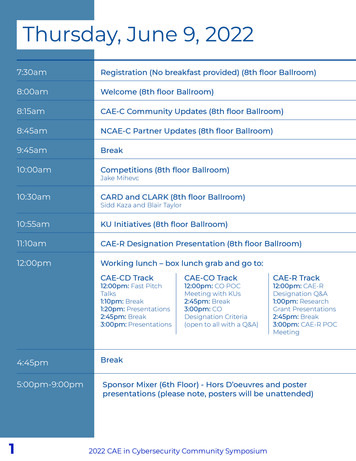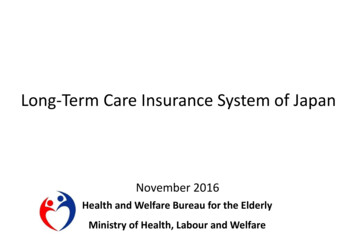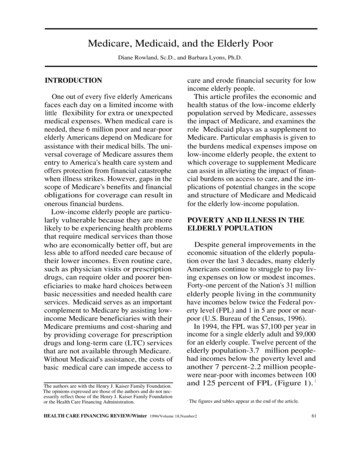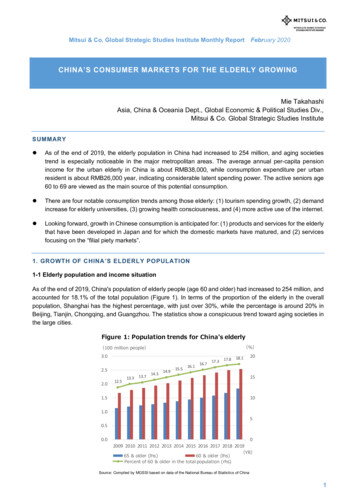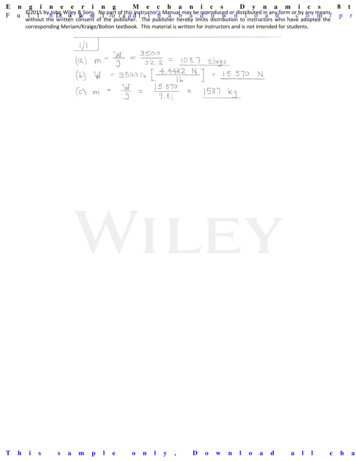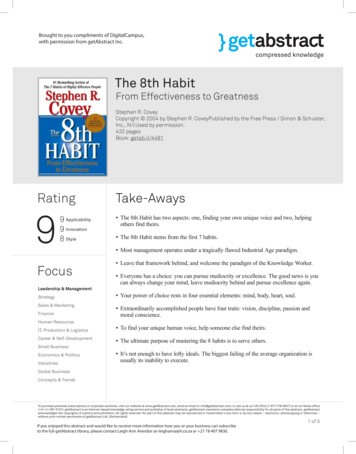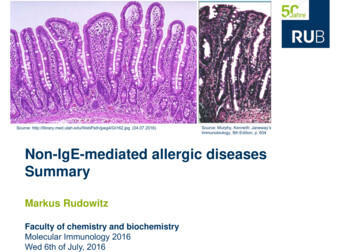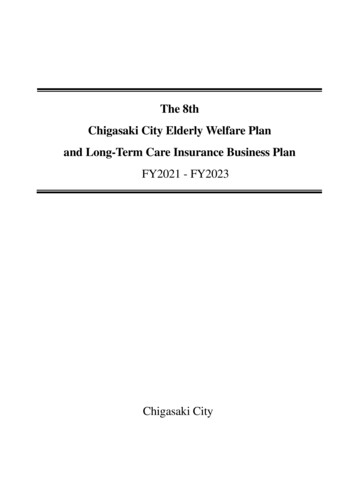
Transcription
The 8thChigasaki City Elderly Welfare Planand Long-Term Care Insurance Business PlanFY2021 - FY2023Chigasaki City
Opening StatementIn recent years, Japan has been facing the challenge of "the coming of a rapidlydeclining population" due to the progress of "aging" and "declining birthrate". Inaddition, the ratio of elderly people to the total population (aging rate) has reached28.4% (White Paper on Aging Society, 2020).As of October 1, 2020, our city had a population of 64,666 people aged 65 and over,and although the aging rate is lower than the national rate, it has reached 26.5%,meaning that more than one in four of our citizens is elderly. While the total populationis expected to gradually decrease, the elderly population is expected to continue toincrease, and the challenge is to create an environment where the elderly can continue to live in good health andvigor in their familiar communities. It is also important that healthy and motivated elderly people, as members ofthe local community, make use of the experience and knowledge they have accumulated over the years to play anactive role in the community.With this in mind, this plan aims to further deepen and promote the "community comprehensive care system"that provides medical care, long-term care, prevention, housing, and lifestyle support in an integrated andcomprehensive manner, with an eye to 2025, when all baby boomers turn 75 years old or older.In order to implement the initiatives in this plan, it is important to have various partnerships and cooperationwith local residents, residents' associations, consumer affairs committee members and child welfare committeemembers, medical, welfare and other organizations and institutions. We would like to ask for the cooperation ofall concerned.Last but not least, I would like to express my sincere gratitude to the members of the Chigasaki City ElderlyWelfare Plan and Long-Term Care Insurance Business Plan Promotion Committee, the approximately 8,000citizens who cooperated with the questionnaire survey, etc., and the many people who contributed their opinionsto the public comments, for their cooperation in the formulation of this plan. I would like to express my deepestgratitude here.March 2021Hikaru SATOMayor of Chigasaki City
The 8thChigasaki City Elderly Welfare Planand Long-Term Care Insurance Business PlanIndexChapter 1 Outline of This Plan . 11 Purpose of Action Plan Formulation . 12 Basic Principles and Basic Policies of the 8th Plan . 43 Positioning of the 8th Plan . 54 Period of the 8th Plan . 65 Progress of the 8th Plan Formulation . 76 Efforts to Promote SDGs . 87 Setting the Daily Living Area . 9Chapter 2 Situation of the Elderly in Chigasaki City . 101 Situation Surrounding the Elderly in Chigasaki City . 102 Results of Main Survey . 19Chapter 3 Review of the Previous Plan. 24Basic Policy 1 Support for the Creation of Diverse Motivation in Living for the Elderly . 24Basic Policy 2 Enhancement of Health Promotion and Care Prevention for the Elderly . 27Basic Policy 3 Creating a Community Where the Elderly Can Live with Peace of Mind . 30Basic Policy 4 Creating a Support System for the Elderly in the Community . 33Basic Policy 5 Early Detection of Dementia and Creation of a System to Support Elderly Peoplewith Dementia . 37Basic Policy 6 Enhancement of Long-term Care Insurance Services and Long-term Care Preventionand Lifestyle Support Services . 39Chapter 4 Basic System of the 8th Plan . 421 Our City's Response to the National Basic Guidelines, etc. 422 Structure of the 8th Plan . 443 Changes from the Previous Plan . 444 System of Measures for the 8th Plan . 46Chapter 5 Measures for Each Basic Policy . 48Basic Policy 1 Support for the Creation of Diverse Motivation in Living for the Elderly . 48Basic Policy 2 Enhancement of Health Promotion and Care Prevention for the Elderly . 51Basic Policy 3 Creating a Community Where the Elderly Can Live with Peace of Mind . 54Basic Policy 4 Creating a Support System for the Elderly in the Community . 57Basic Policy 5 Early Detection of Dementia and Creation of a System to Support Elderly Peoplewith Dementia . 64
Basic Policy 6 Enhancement of Long-term Care Insurance Services and Long-term Care Preventionand Lifestyle Support Services. 68Chapter 6Future Prospects for Long-Term Care Benefits and Long-Term Care InsurancePremiums . 721 Future Estimate . 722 Future Prospects for Insurance Benefits, etc. . 743 Establishment of Development Targets for Long-Term Care Insurance Facilities, etc. . 874 Calculation of Insurance Benefit Costs, etc. and Long-Term Care Insurance Premiums. 90Chapter 7 Progress Management . 941 Promotion System of This Plan . 942 Progress Management of This Plan. 96 The percentages in the text and in each table and graph are rounded to the first decimal place. Therefore,there may be cases where the total, the total of the breakdown and the balance do not match (e.g., the totalof the breakdown does not reach 100%). The same applies to the amounts shown in thousands of yen. The "n" (abbreviation for "number of case") in the survey results graph indicates the number of respondentsto the question. Various statistical data as well as survey results is used in the text. The city’s main efforts in "Chapter 3: Review of the Previous Plan" are the results of FY2019.
Chapter 1 Outline of This PlanChapter 1Outline of This Plan第1章 本計画の概要1Purpose of Action Plan Formulation1 計画策定の趣旨(1) Increase of elderly populationAccording to the "Population Projections for Japan: 2016 to 2065" by National Institute of Population andSocial Security Research (IPSS), the population of the elderly in Japan is expected to reach 30% in 2025 and1.5 working-age people will support one elderly person in 2040. This has become a major issue in Japan asthe 2025 problem and the 2040 problem, respectively.As for the current situation of Chigasaki City, the total population is slowly increasing and the elderlypopulation is also increasing year by year, but in the future, the total population is expected to decrease whilethe elderly population is expected to increase. As of October 1, 2020, the population aging rate according tothe Basic Resident Register was 26.5% (64,666 residents), and the ratio of people aged 65-74 (so-calledyoung-old) was 12.5% (30,576 residents). The ratio of people aged 75 and over (so-called old-old) was 14.0%(34,090 people) and is expected to continue to rise significantly in the future.The number of persons certified as requiring long-term care and support (hereinafter referred to as "personscertified as requiring long-term care, etc.") is also increasing, and as of the end of September 2020, the numberof persons certified as requiring long-term care, etc. (primary insured persons) is 10,625, and the certifyingratio (the ratio of persons certified as requiring long-term care, etc. to the total number of elderly persons aged65 and over) is 16.4%.(2) The direction of the country toward 2040As Japan as a whole is facing an increasingly serious problem of aging, the "Act for Partial Revision of theLong-Term Care Insurance Act, etc. for Strengthening the Community Comprehensive Care System" wasenacted in May 2017, with two major pillars: "deepening and promoting the community comprehensive caresystem" and "ensuring the sustainability of the long-term care insurance system.Toward "deepening and promoting the community comprehensive care system," we will create a system tosupport independence and prevent the severity of illness, promote cooperation between medical care and longterm care, and take measures to realize a community symbiotic society. For "ensuring the sustainability of thelong-term care insurance system," it is necessary to strengthen efforts to secure human resources for long-termcare and improve the efficiency of long-term care operations in order to secure a human resource base tosupport the elderly in the community we will work to secure the human infrastructure to support the elderlyin local communities, as the number of working-age people who will be responsible for the system declinessignificantly.In addition, based on the "Plan for Extending Healthy Life Expectancy" (Ministry of Health, Labor andWelfare), which aims to increase healthy life expectancy to 75 years or more for both men and women by2040 by strengthening approaches to those who are indifferent to health and eliminating disparities amongregions and insurers, it is necessary to promote measures for preventing long-term care, frailty, and dementia,1
as well as to improve the environment so that the elderly and other motivated people can play an active rolein society.(3) About the situation in Chigasaki CityUnder these circumstances, in the 7th Chigasaki City Elderly Welfare Plan and Long-Term Care InsuranceBusiness Plan (the plan period is from FY2018 to FY2020; hereinafter referred to as the "7th Plan"), we havebeen working to deepen and promote the "Community Comprehensive Care System," which provides medicalcare, long-term care, prevention, housing, and life support services in an integrated manner.The 8th Chigasaki City Elderly Welfare Plan and Long-Term Care Insurance Business Plan (hereinafterreferred to as the "8th Plan") has been established. In the 8th Plan, based on the contents of the 7th Plan andits issues, we will organize the items to be addressed in the elderly welfare measures and long-term careinsurance business for the next three years, and also promote the plan by incorporating the concept of theSustainable Development Goals (SDGs), which are international goals that aim to create a sustainable andbetter world by 2030, into each basic policy.Since the six basic policies of the 8th Plan are linked to the five components of the communitycomprehensive care system (medical care, long-term care, prevention, housing, and life support), promotingthe 8th Plan will lead to further deepening and promotion of the community comprehensive care system. Inaddition, as a new idea in the 8th Plan, we will replace the current three daily living area with new 13 areas,which are the same as the city's urban development units, to improve consistency with the city's policies inorder to solve regional issues.As a countermeasure against infectious diseases such as the COVID-19, which has been spreadingworldwide, we will continue to review our projects. In order to ensure that the elderly can lead safe and securelives, we will work together with the national and prefectural governments to implement countermeasures andbuild a system in the communities in cooperation with businesses and facilities, while reviewing projects andtaking other measures to adapt to new lifestyles.In the 8th Plan, we will build a system that can flexibly respond to external factors such as disasters, whilesteadily developing measures. Looking ahead to 2025 and beyond, when all baby boomers will be 75 yearsold or older, we will work to extend healthy life expectancy and further deepen and promote the communitycomprehensive care system, aiming to realize a community symbiotic society.2
Chapter 1 Outline of This Plan Chart 1 The Conceptual Picture of Community Comprehensive Care SystemWhen you get sick Medical CareThe Conceptual Picture ofCommunity Comprehensive Care SystemHospital Visit Day Care,Hospitalization Home CareHospitalAcute, Recovery, Chronic・Community ComprehensiveLong-term Care・Home-based Services・Home care ・Home nursing・Day care・Facility-based Services・Long-term care facility・Small-scale multifunctionalfor the elderlyin-home care・Geriatric health services facility・Short-term hospitalization・Group homedaily living care・Living care for residents in・24-hour home visit servicespecific facilitiesetc.・Complex services(Small-scale multifunctional in-home service plus Home nursing)Daily Medical Care・Family doctor,Bed-and-breakfast clinic・Local partner hospitals・Dental care, PharmacyWhen you need long-term care Housingsupport center・Care manager・Long-term Care Prevention Service, etc.Consultation andcoordination of servicesTo live a healthy life foreverLife Support,Long-term Care PreventionThe community comprehensive caresystem is assumed to be based on the areaof daily life (junior high school districts)where necessary services can be providedwithin approximately 30 minutes.Senior citizens' clubs, Community associations, Volunteers, NPOs, etc.(Source, Ministry of Health, Labour and Welfare)3
2Basic Principles and Basic Policies of the 8th Plan2 第8期計画の基本理念と基本方針Basic PrincipleIn this super-aging society, we will promote the creation of a system in which the power of mutualsupport in the community can function in a coordinated manner and be effective, so that the elderly canlead independent daily lives according to their abilities in their familiar communities as much aspossible, and aim to realize fulfilling daily lives for each and every elderly person. Chart 2 Basic System Conceptual DiagramSecuringHumanSupport for ResourcesBusinessesSocialParticipationHobby andPurpose of LifeAppropriatenessof BenefitsFacilityMaintenanceEmploymentSupport for theCreation of DiverseMotivation in Living Basicfor the ElderlyPolicy 2Enhancement ofLong-term Care InsuranceServices and Long-termCare Prevention andLifestyle Support ServicesEstimatedAmount ofBenefits, etc.Enhancement ofHealth Promotion andCare Prevention forthe ElderlySupportBasic Policy 5Consultation(Dementia)Knowledge andUnderstandingEarly Detection ofDementia andCreation of a Systemto Support ElderlyPeople withDementiaHealthBasic Policy 1Basic Policy 6BasicPrincipleLong-term CarePreventionLivingEnvironmentBasic Policy 3Creating aCommunity Wherethe Elderly Can Livewith Peace of MindSafety andSecurityDisasterBasic Policy 4Creating a Support System forthe Elderly in the CommunityEarly Detectionand ResponsePreventionProvision ofInformationRightsProtectionMedical andLong-term lihoodSupport
Chapter 1 Outline of This Plan33Positioning of the 8th Plan第8期計画の位置づけ(1) Legal positioningThis plan is to be formulated as an integrated "Municipal Welfare Plan for the Elderly" based on the ElderlyWelfare Law (Article 20-8) and "Municipal Long-term Care Insurance Business Plan" based on the Longterm Care Insurance Law (Article 117). The plan is to be formulated in conjunction with the "KanagawaElderly Health and Welfare Plan" formulated by Kanagawa Prefecture.(2) Positioning in city governmentThis plan is positioned as a divisional plan for the welfare sector in the "Chigasaki City ComprehensivePlan", which is the top-level plan.In addition, the "Chigasaki Community Welfare Plan 2 for Everyone to Connect (the 4th Chigasaki CityCommunity Welfare Plan, the 6th Chigasaki City Community Welfare Activity Plan, and the 1st ChigasakiCity Basic Plan for the Promotion of the Use of the Adult Guardianship System), which is a comprehensiveplan for the health and welfare sector, will be used as the top-level plan, and will be carried out in line withthe "Chigasaki City Health and Welfare Plan for Persons with Disabilities", the "Chigasaki City Child andChild-Raising Support Project Plan", and other plans for other sectors. Chart 3 Positioning the PlanChigasaki CityComprehensive PlanHealth and welfare related plansRelated plansin other fieldsChigasaki Community Welfare Plan 2for Everyone to Connect【Community Welfare Plan, Community Welfare Activity Plan,Basic Plan for the Promotion of the Use ofthe Adult Guardianship System】Matters that should be addressed in commonwith regard to the community welfare promotionOther Health and Welfare RelatedPlanChild and Child-Raising SupportProject PlanHealth and Welfare Plan forPersons with DisabilitiesElderly Welfare Plan,Long-term Care InsuranceBusiness Plan5Urban Master PlanRegional DisasterPrevention Plan・・・・
4Period of the 8th Plan4 第8期計画の計画期間The planning period for this plan is three years, from FY2021 to FY2023.In the 8th Plan, we will work to further deepen and promote the "Community Comprehensive Care System,"which we have been aiming to establish in stages since the 6th Plan, by taking into consideration the situationof elderly people and demand for long-term care in Chigasaki City in 2025, which is during the 9th Plan period. Chart 4 Planning PeriodAll baby boomers will become 28The 7th PlanThe 8th Chigasaki City ElderlyWelfare Plan and Long-Term CareInsurance Business Plan(This plan)The 9th PlanThe 10th PlanMedium- to long-term outlook to FY202562029
Chapter 1 Outline of This Plan5Progress of the 8th Plan Formulation5 第8期計画策定の経過け(1) Survey implementation and collection statusWe conducted the "Survey on the 8th Chigasaki City Elderly Welfare Plan and the Long-Term CareInsurance Business Plan" in order to understand the opinions and requests of the elderly and their familiesbefore formulating the 8th Plan.The status of survey collection is as follows.(Type of Survey)(Subject) 1 Individual Survey of the General Elderly(Persons aged 65 or over (excluding those certified asrequiring long-term care, etc.)) 2 Individual Survey for Persons Certified as RequiringLong-term Care or Support (at Home)(Those who are certified as requiring long-term careor support and are living at home) 3 Individual Survey for Persons Certified as RequiringLong-term Care or Support (at Facilities)(Those who are certified as requiring long-term careor support and are using facility services, etc.) 4 Long-term Care Prevention and Daily Living AreaNeeds Assessment(Persons aged 65 or over (including those certified asrequiring support)Number ofSurvey TargetsNumber of ValidResponsesRate of 48.4%2,3751,88179.2%(2) Progress of discussions at the Promotion Committee and Liaison and Coordination MeetingThe "Chigasaki City Elderly Welfare Plan and Long-Term Care Insurance Business Plan PromotionCommittee" (hereinafter referred to as the "Promotion Committee") consists of 14 members, including citizensfrom the public, representatives of public organizations, etc. within the city area, representatives oforganizations engaged in activities related to elderly welfare, representatives of long-term care serviceproviders in the city area, and people with academic experience.In order to formulate this plan, the council deliberated at the Promotion Committee, and at the "ChigasakiCity Elderly Welfare Plan and Long-Term Care Insurance Business Plan Liaison and Coordination Meeting",which consists of 19 members from relevant departments and sections of Chigasaki City.On March 27, 2019, we consulted the Promotion Committee on the formulation of the plan, and on October30, 2020, the Promotion Committee reported on the "8th Chigasaki City Elderly Welfare Plan and Long-TermCare Insurance Business Plan (Draft)".(3) Implementation of pubic commentsFor about one month from November 25 to December 24, 2020, the 8th Plan (Draft) was distributed at theElderly Welfare and Care Division counter, the City Government Information Corner, each branch office, eachcommunity center, and other public facilities. At the same time, we published the draft plan on the city websiteand solicited opinions on the plan.Through this public comment, we have received 16 opinions from 3 different people.7
6Efforts to Promote SDGs6 SDGs推進に向けた取組(1) What is the SDGs?The Sustainable Development Goals (SDGs) are common goals for the international community as a whole,adopted by consensus of all 193 countries including Japan at the United Nations Summit in September 2015.It consists of 17 goals (targets) to be achieved between 2016 and 2030, and 169 targets that are linked to thegoals and are presented in concrete terms. Chart 5 17 goals of SDGs The 17 goals are listed on page 104 of the "Materials" section.(2) Promoting the SDGs and this planIn the Chigasaki City Comprehensive Plan, which will be launched in FY2021, citizens, businesses, andthe government will share the policy goals of Chigasaki City by having a common language of SDGs, deepentheir partnership, and aim to solve regional issues by utilizing each other's strengths. In this plan, too, diverseentities will collaborate and cooperate to promote the plan based on this idea.Specifically, we will clarify (position) which SDGs our efforts to achieve each basic policy target willcontribute to. Chart 6 Examples of SDGs in Basic Policy 1 of this planBasic Policy 1 Support for the Creation of Diverse Motivation in Living for the ElderlySocial ParticipationHobby andPurpose of Life(1) Promotion of social participation of theelderly and support for community activities(2) Support for creating hobbies and a sense ofpurpose in life(3) Enhancement of employment supportWork8
Chapter 1 Outline of This Plan7Setting the Daily Living Area7 日常生活圏域の設定(1) What is the daily living area?In order to enable the elderly to continue their lives while receiving appropriate services in their familiarareas, the municipalities are divided into areas called "daily living areas" according to the characteristics ofthe area, taking into account such factors as geographical conditions, population, transportation, and othersocial conditions, as well as the status of facilities for providing services such as long-term care benefits.(2) Review of the daily living areaIn consideration of the fact that the number of elderly people per area was small at the time of theestablishment of the daily living areas (2006), the number of daily living areas was set at three. However,considering the fact that the number of elderly people per area is increasing with the aging of the population,and there are many activities in each district, the daily life areas will be set to 13 areas, which are the same asthe city's urban development units. This will make it possible to better align the city's urban developmentpolicies with those of the long-term care insurance business plan. In addition, a new "service infrastructurearea" will be established to serve as a unit for the development of a system for the provision of communitybased services, including the development of facilities for community-based services. Chart 7 Daily Living Areas and Service Infrastructure AreasArea AreaArea 2MatsunamiAreaShonanAreaArea 1NangoAreaKaiganAreaChigasakiMinami AreaTsurumineNishi AreaTsurumineHigashi AreaService InfrastructureAreas (3 areas)ChigasakiAreaDaily Living Areas(13 areas)
Situation of the Elderly in Chigasaki CityChapter 2第2章 on Surrounding the Elderly in Chigasaki City1 茅ヶ崎市の高齢者を取り巻く状況(1) Changes in the population of Chigasaki CityBased on the Basic Resident Register, the total population as of January 1, 2020 is 243,884, an increase of morethan 3,000 people from five years ago, with a five-year growth rate of 1.4%. The growth rate for the same periodin Japan and Kanagawa Prefecture was less than 1.0%. Although the population of our city is increasing, the rateof population growth is on a downward trend. Chart 8 Chigasaki City's Total Population and Growth Rate Compared to Those of Japan and Kanagawa PrefectureFY2000Chigasaki 0Total PopulationGrowth Rate (%)Total PopulationGrowth Rate (%)Total PopulationGrowth Rate (%)(Source: Basic Resident Register, as of March 31 for 2010 and earlier, and as of January 1 for 2015 and later) Chart 9 Chigasaki City's Total Population and Its Growth 2015FY2020Growth Rate(Source: Basic Resident Register, as of March 31 for 2010 and earlier, and as of January 1 for 2015 and later)10
Chapter 2 Situation of the Elderly in Chigasaki City(2) Population structure of Chigasaki Cityi) Population changesBy the three age groups, the young population has decreased by 1,659 since 2012, and the working-agepopulation has decreased by 4,017 since 2012. The elderly population, on the other hand, has increased by morethan 10,000 since 2012, especially the old-old population has surpassed the young-old population in 2018 and theyoung population in 2019. Chart 10 Chigasaki City's Population by the Three Age Groups(unit: Y2019 opulationYoung-old(Aged 65-74)Old-old(Aged 75 )TotalPopulation(Source: Basic Resident Register, as of October 1 of each year)ii) Changes in composition ratioLooking at the composition of the population by the three age groups, the working-age population declinedfrom 63.8% in 2012 to 60.6% in 2020, while the elderly population continued to rise from 22.3% in 2012 to 26.5%in 2020. Chart 11 Changes in the Population Composition by the Three Age Group in Chigasaki City(%)FY2012FY2013FY2014Young Population(aged 0-14)FY2015FY2016FY2017Working-age Population(aged 15-64)FY2018FY2019FY2020Elderly Population(aged 65 or over)(Source: Basic Resident Register, as of October 1 of each year)11
(3) Aging ratei) Aging rate in Chigasaki CityThe aging rate in our city has been rising year by year, and since 2016, more than one in four of our citizens areelderly. If we divide the elderly population into the young-old and the old-old, we can see that the young-old is ona downward trend while the old-old is on an upward trend. Chart 12 Aging Rate in Chigasaki City(%)FY2012 FY2013 FY2014 FY2015 FY2016 FY2017 FY2018 FY2019 FY2020Young-oldPopulation Ratio(Aged 65-74)Old-oldPopulation Ratio(Aged 75 or over)Aging Rate(Source: Basic Resident Register, as of October 1 of each year)ii) Comparison with Japan and Kanagawa PrefectureIn comparison with the aging rate in Japan and Kanagawa Prefecture, our city's rate continues to rise as in Japanand Kanagawa Prefecture, however, the rate is lower than the national rate and higher than Kanagawa Prefecture. Chart 13 Aging Rate in Chigasaki City Compared to That of Japan and Kanagawa higasaki CityFY2019FY2020Japan(Source: Basic Resident Register, Demographic and Household Surveys, as of January 1 of each year)12
Chapter 2 Situation of the Elderly in Chigasaki City(4) Population and aging status by the daily living areaBy the daily living area, the aging rate has increased in all a
care, long -term care, prevention, housing, and life support services in an integrated manner. The 8th Chigasaki City Elderly Welfare Plan and Long-Term Care Insurance Business Plan (hereinafter referred to as the "8th Plan") has been established. In the 8th Plan, based on the contents of the 7th Plan and its issues, we will organize the items .


